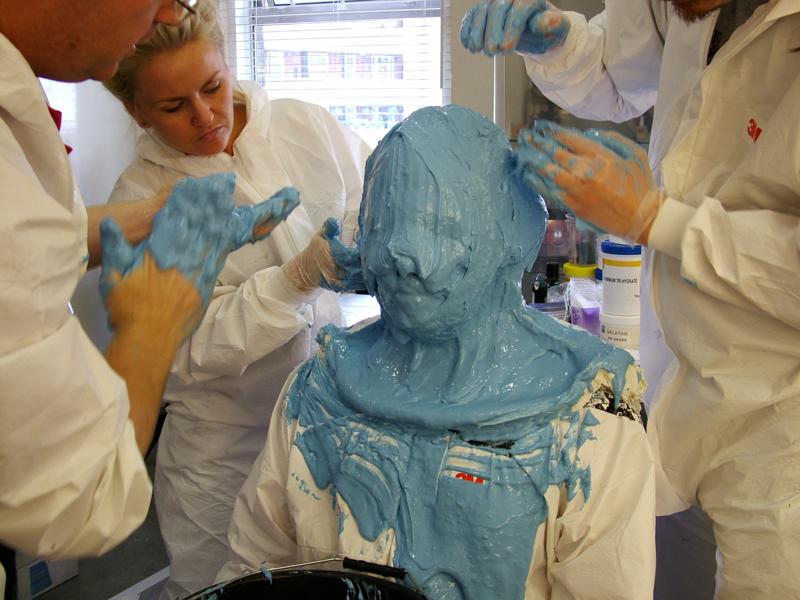 Lifecasting is a basic, essential skill in creating custom fitted prosthetics.
Lifecasting is a basic, essential skill in creating custom fitted prosthetics.
Often it’s the first process before work begins in earnest, so it’s really a good idea to do it well. Errors made at this stage get passed on throughout each process.
Scroll down to the bottom to hear the latest podcast on this.
We had a couple of questions regarding lifecasting, and seeing as there are as many techniques and variations as there are people taking lifecasts that it would be cool to bring together some of the best tips and tricks picked up from working with others.
This won’t be an exhaustive tutorial on lifecasting, as this has been covered so well by others in great detail. A great example is Lifecasting with Silicones and Alginates by Neill Gorton, available as a DVD and stream which pretty much covers everything in great detail! Rather than reinvent the wheel, we thought sharing our tips and tricks to build on the information available would be beneficial to you life casters at large!
If you want to check out a little lifecasting to whet your appetite, take a look at some videos of a face and hand cast I made with artist and well known makeup tutorial YouTuber, Klaire De Lys a while back:
What is a lifecast and why do you need one
Lifecasting is making a three dimensional duplicate of a real body part, usually a face or head, of a live person. Usually you do this because you need a copy of the performer in order to make a custom fitting prosthetic which needs to fit them exactly. It can also be used to make bodies or body parts which are accurate to the performer without sculpting it from scratch.
This severed head was for a TV production of Dracula, for Kristyan Mallet.. The original headcast was done by Kristyan, who then filled the alginate cast with melted plastiline. I simply cleaned up the cast, opened the eyes and added some gory neck stump textures to create the severed head.
This is often the case for severed heads etc. where it would be a lot more effort to sculpt a lifelike portrait when an accurate lifecast can be made in twenty minutes. By melting plastiline and pouring this inside the negative mould taken from the person, a positive version can be made which can easily be sculpted and modified once the plastiline has cooled and returned to a solid state.
Digital Alternatives
An alternative to lifecasting is to take an accurate 3D scan. There are different ways of doing this with hand-held scanners to booths in which a subject sits or stands in either a static chair or a turntable.
There is also software such as 123 Catch from Autodesk and Photomodeller by Eos Systems Inc. which can stitch a series of images together and creates a 3D virtual model which can then be modified and output to a 3D printer or cutting machine.
This interesting video shows how a simple idea can be turned into an incredible effect – just imagine how this could be used in makeup effects: http://vimeo.com/43442146#

Polystyrene machined tool of body scan used by Millennium FX for Dr Who.
Digital scans are already sometimes used instead of conventional body casts. Due to the size, it is machined out of a lightweight material like polystyrene by companies like Bakers Patterns, so the fine detail isn’t available in the cast but for large body suits this detail isn’t necessary anyway.
However, lower resolution detail is compensated for with the accuracy scans can have, as the pose isn’t required to be held for long periods as with conventional casting.
There is no distortion or discomfort due to casting material weight, and modifications can be made to the virtual model before being machined, such as elongation of limbs to offset the effect of shrinkage in foam latex. The lightweight styrene parts can then be finished and remoulded as usual to create master moulds yielding multiple casts in whatever materials you need for the job.
It is also possible to scan a performer in one country and send the data to another for production. This is useful if an actor is located far from where the suit is being made and can remove the need for flying a performer in for a lifecast or transporting a lifecasting crew with a heavy or awkward mould.
Other industries are using technology like this all the time, so just like you learn to mix alginate and use plaster bandage, it makes sense to get familiar with the emerging technologies.
Safety!
- Lifecasting should not be attempted without supervision when you start out. There is scope for error when doing this – it’s not terribly difficult to do a lifecast. Nor is it difficult to do it badly, so make sure you know what is involved before you start. Get supervision and training first.
- Make sure the subject is well and safe enough to take part. Conditions and illnesses which could put them at risk are not worth taking a chance on just for a lifecast!
- Don’t use straws up the nose! It may seem like a good idea, but not only does it mean the cast will be a distorted one with straws stretching the nostrils out, but if they get knocked accidentally then it could cut into their nasal passage. Yikes!
- Setting up the lifecasting room and getting everything you need beforehand is very important. Make sure you have help, so the person in the cast is never left alone if you need to leave the room.
- Make sure you have sufficient protection for the floor, tables or working surfaces and clothes! Plastic sheeting on carpet is essential – although better to try to not work on carpet!
- Make sure any plastic is taped down securely and pulled tight so you don’t trip up over wrinkles or folds in it.
- Think not only about the room you are working in, but the route you will need to take to get to sinks/toilets/outside etc. Plastery footprints trailing through hallways are a nightmare to clean up!
- Do not pour any plaster or plaster-water into the sink or drains as it can set in the pipes and cause a very expensive blockage! Fit a plaster trap if possible, or allow the plaster residue to settle overnight in the buckets so the water can be poured off safely the next day whilst the remaining sludge can be scooped out and put into the trash or waste collection. It’s worth getting extra buckets so you can get fresh water if needed without emptying the dirty water first!
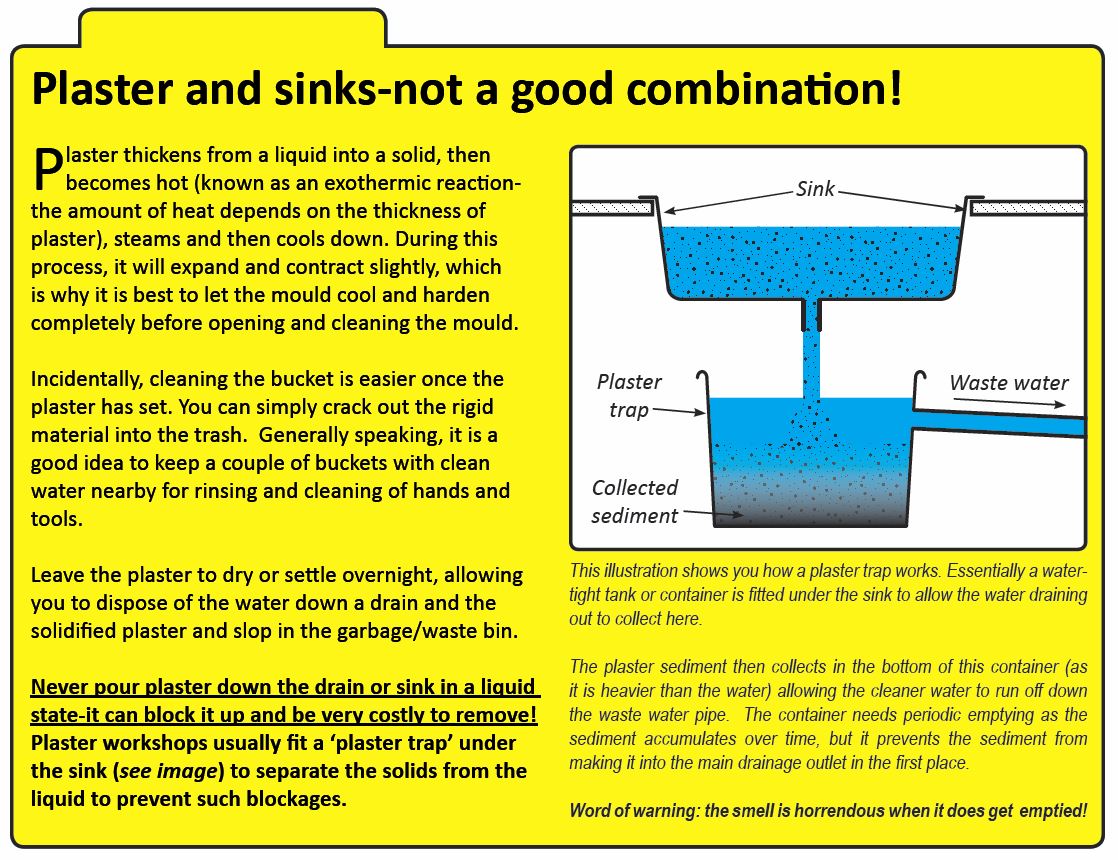
This little excerpt from my Awesome Latex Ecourse shows how a simple plastic tub hooked up to the waste pipe under the sink can help stop the drains from getting blocked with sediment from plaster, clay and general mould-making mess.
Alginate or Silicone?
Alginate
Dental alginates have been used for years to make lifecasts, and it works well. The main benefits of alginate are they are quicker and cheaper than silicones, but the trade off is that you can really only get one cast out of it. This isn’t a problem as you usually clean up the original cast and make a master mould in a silicone afterwards.
H0wever, if you are only intending to make one anyway – or don’t have the time or materials to make a master mould which can produce multiple copies later – then you need not waste the extra on using silicone.
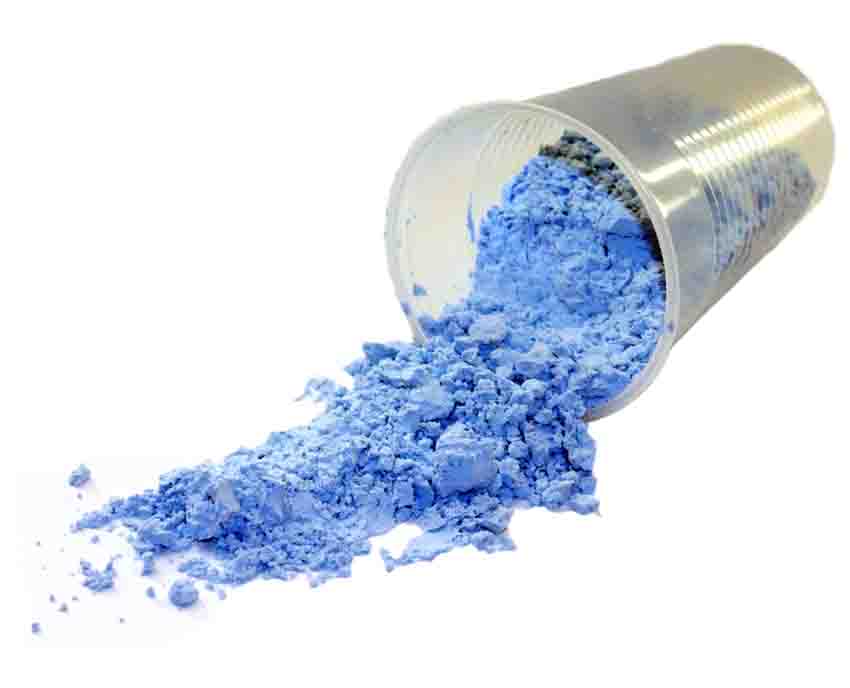 Alginates are usually a powder, mixed in a bucket with water by hand or using a mixer attachment in an electric drill. It is often quite quick setting, although you can get slower setting alginates for body casting large areas.
Alginates are usually a powder, mixed in a bucket with water by hand or using a mixer attachment in an electric drill. It is often quite quick setting, although you can get slower setting alginates for body casting large areas.
By adding a small amount of a slower setting alginate to standard set alginate, you can increase the working time more gradually, although emphasis on the subjects comfort mean quicker is usually better. A full head should really be covered in alginate within two minutes, so a working time of more than five is excessive for most purposes.
Once alginate has set up, fresh alginate does not usually stick to it, so any areas which need additional coats will need an alginate bonder. It is therefore desirable to get the cast done in a a single mix. To be more clear on working times, it makes sense to do a test mix of the material and time the setting with a timer or stopwatch so you and the subject both know how long you have before it sets.
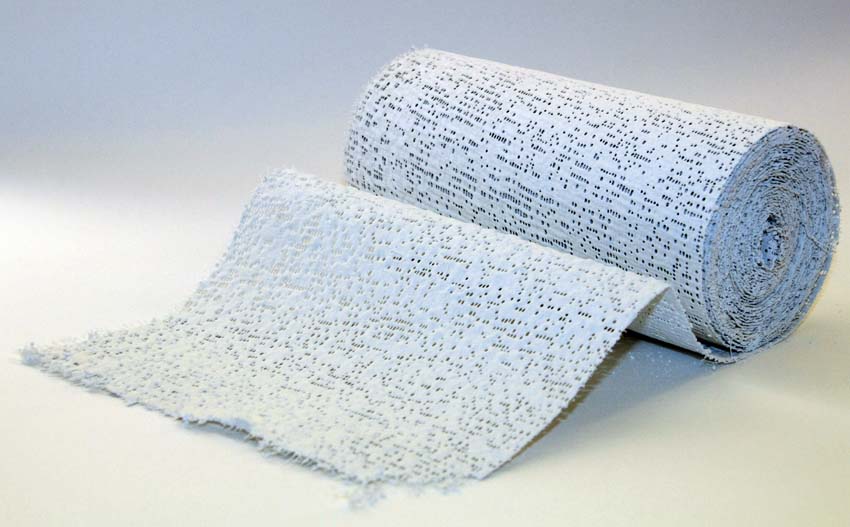 As alginate remains flexible once set, it needs a rigid jacket applied to the outside to support it and retain the correct shape. If you peeled it off now, it would just be a big flexible face-shaped bowl and would distort, making it impossible to fill with plaster.
As alginate remains flexible once set, it needs a rigid jacket applied to the outside to support it and retain the correct shape. If you peeled it off now, it would just be a big flexible face-shaped bowl and would distort, making it impossible to fill with plaster.
Once set, alginate quickly dries as the water content begins to evaporate and can shrink, so it needs filling with plaster quickly to retain accuracy. If you are unable to fill the cast immediately, you can keep the alginate damp with wet tissues and sealing in a plastic bag to keep air out.
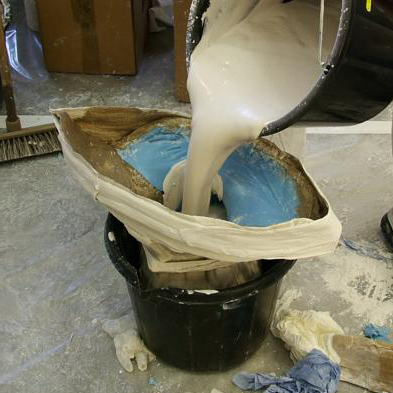
Plaster bandage is used to keep the soft alginate steady so when plaster is added, it stays the same shape and creates an accurate cast.
This will be ok for a day or so, but it will eventually become mouldy and unusable, so fill it as soon as possible. Alginate can tear easily so be careful when handling, however it can be repaired with superglue for a quick fix.
Silicone
There are a number of makes, most notable Smooth-On’s Body Double, and Mouldlife’s Life Form. Essentially the process is the same – two parts are mixed together (usually in equal amounts) to create a pate which is then applied to skin before setting.
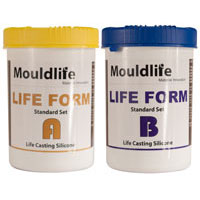
Mould Life make Life Form, a great life casting silicone which releases beautifully from hair!
Silicone can be built up in multiple layers, as unlike alginate, it sticks to itself well. This means any thinner areas can be reinforced easily, and missed spots or holes are easily repaired with additional mixes added.
Because of this, it can take a little longer to do a cast which isn’t ideal if the subject is nervous, although with experience you can take casts using silicone just as quickly by working efficiently and applying it well.
Once the silicone has set, it still needs a rigid jacket to keep the shape and usually this is still done with plaster bandage. As there is no water involved in mixing silicone, it doesn’t shrink and there is no need for immediate filling unlike alginate – handy if you are travelling with casts.
The final mould is reusable, and much more durable, yielding many casts from it. Although this is handy, if you have not done a great job of applying it, each cast from the mould will naturally have the same air bubbles, defects and distortions. You may still therefore need to make a master mould anyway. The benefit however is several people can get plaster casts and go to work on sculpting whilst the master mould is being made. Silicone is more expensive than alginate, but the extra costs is worth it if you intend to reuse moulds and make multiple casts.
Accuracy
With any lifecast, it is advisable to take photos from all angles, and take head measurements with a tailors tape so you can refer back after the cast and check accuracy. After all, the idea is to get as accurate a duplicate of the person as possible, so taking time to make sure you have a record of the real thing is helpful once they have left the studio and you are wondering if the lumps and bumps on the cast are down to your technique or their diet!
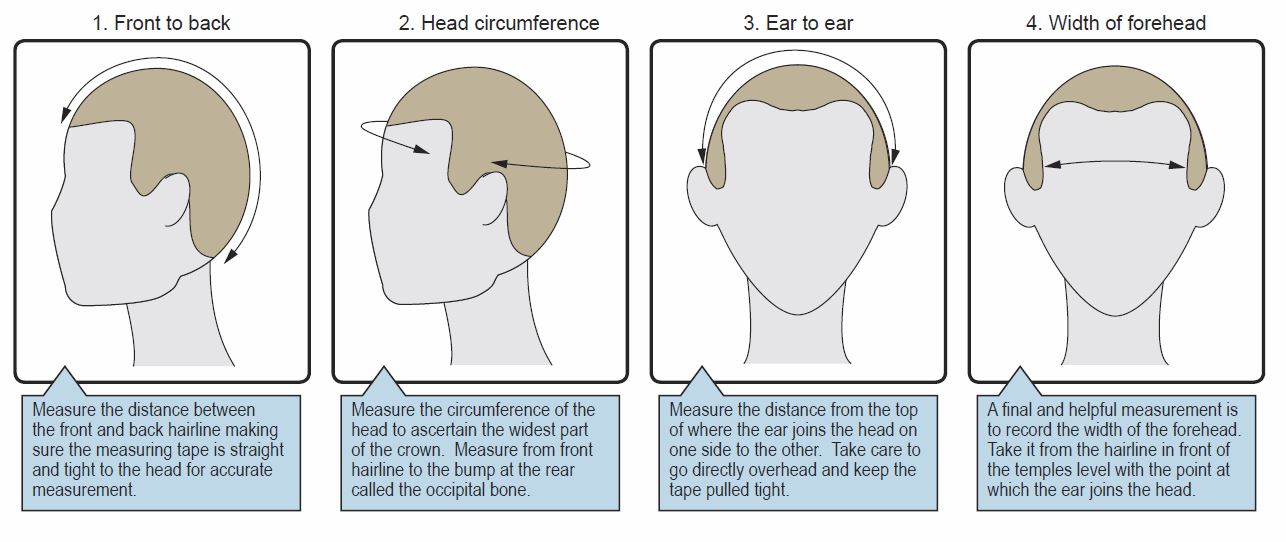
Measuring the head circumference and marking the hairline will enable you to check that the final plaster cast is indeed accurate, and any mass created by hair under the baldcap is accounted for and shaved down.
Uneven shoulder shoulders, twisted noses or eyes at different levels may not be noticed in the flesh but may be apparent in the plaster cast later so verify with the reference to be sure. Usually casts need to be made in a neutral position, so care must be taken to avoid slouching, head tilted to one side etc. unless this is needed in the final cast.
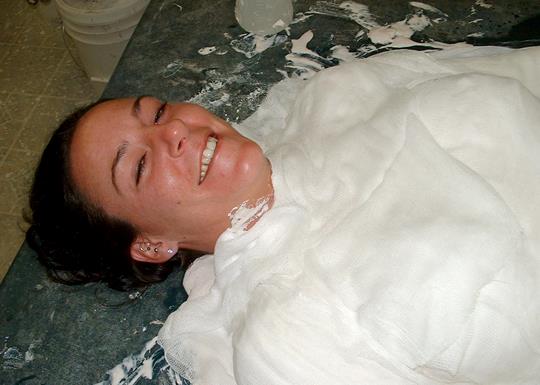
This image, courtesy of Todd shows a bodycast taking place. Picture courtesy of Todd Debreceni.
If the purpose of taking a cast is to make a corpse lying on a floor, it makes sense to cast them lying in the correct pose.
If you take a cast of a person standing up, and lay a copy of it on the floor, it won’t look like it is lying down at all! The way the body flattens out and limbs sit when relaxed is completely different to when the body is standing up and defying gravity!
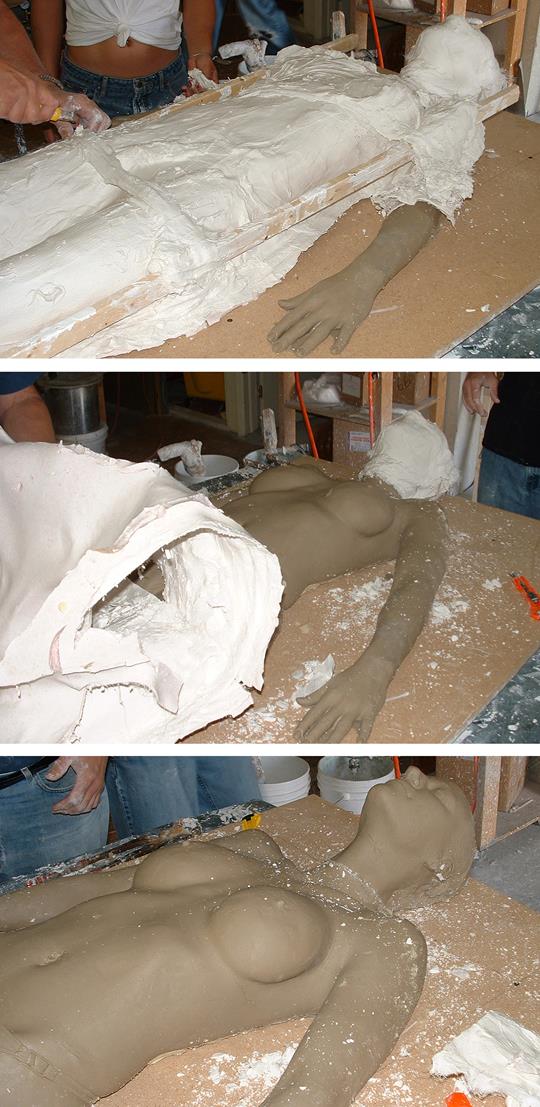
The cast, being taken whilst lying down, is an accurate version of the body in repose, with the skin and limbs flattening and spreading naturally as they would in that position. Picture courtesy of Todd Debreceni.
Face casts for prosthetics are normally taken sitting upright, as this is the position the face is likely to be when the appliances are worn. Having a face cast done lying down or at an angle may make the face distort slightly, especially once the additional weight of the casting material is applied to skin.
Check out our lifecasting podcast to stream or download here:
And remember, if you have an FX makeup question, sling it our way so we can get busy! Email us at stuartandtodd@gmail.com!
Stuart & Todd

Hi, I m profphesnal manufecturer of China.. wan to know if I can have the sex with lifecast? is safe ok for sales? plase cuntact xiomei.zhung@xumi.ch.net, meybe we partnershap. 我很感激。 , 小米张
What do you recommend filling the lifecast with? Any certain brands that would be suitable for a beginner? I will mainly use latex, so it cannot bond to it.
Thank you!
What do you recommend filling the lifecast with? Any certain brands that would be suitable for a beginner? I will mainly use latex, so it cannot bond to it.
Thank you!
Hey I am a makeup artist and hoping to branch into SFX and am looking to create my own cast and was wondering if you can recommend any alginate brands and any other brands that you find help in this process?
I like the Tiranti stuff and Mouldlife have a couple – the 3 minute is pretty quick and they do a slower setting version too. PS Composites have good stuff also.